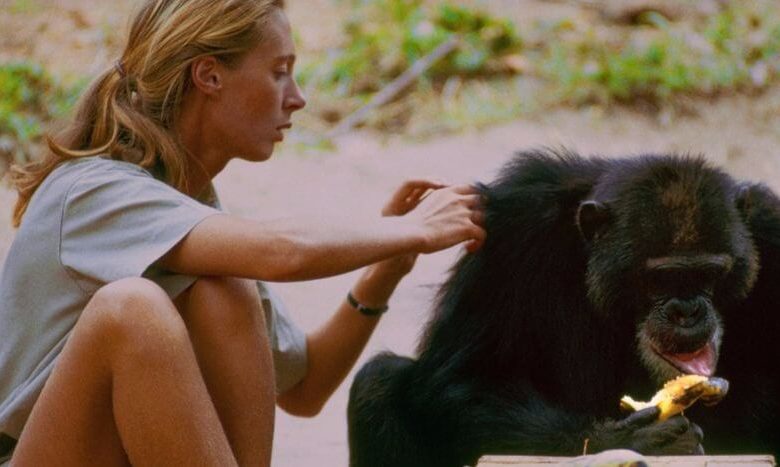
There are names that automatically bring to mind a lifetime of research and empathy towards simians.
- Dian Fossey’s extensive time with mountain gorillas
- Birute Galdikus’ study of orangutans
- Jane Goodall’s experiencing chimpanzees in their natural habitats
All three were assigned to their research by Dr. Louis Leakey, whose group has cheekily been referred to as “The Trimates.”
Despite whatever skepticism these women endured, their observant studies of beautiful, endlessly fascinating mammals has proven valuable and illuminating to the scientific community.
Now, while Fossey’s story was turned into a well regarded Sigourney Weaver vehicle and Galdikus’ life remains untouched by Hollywood, we have a documentary about Goodall that might be definitive.
“Jane” features material compiled from more than 100-hours of often eye-popping footage and an interview with Goodall, now 83. Audiences can experience how incredible her mission was to undertake and how life changing the result was for her.
We learn that Goodall was a 26-year British secretary of Leakey’s with only a love and patience for animals as her credentials. She lived in Gombe Stream National Park in Africa during the early 1960s, took extensive notes of her findings and, after making little progress at first, found herself in the midst of chimpanzees with whom she bonded with for years.
RELATED: ‘California Typewriter’ – The Perfect Antidote for Our Digital Age
Director Brett Morgen’s “Jane” is a major feat in documentary filmmaking, a marvel composed from hours of never before seen footage. A sequence in which Goodall’s camp is attacked by aggressive chimps is a prime example.
The choice of edits, as we cut to Jane’s reaction to the ruckus, and the initially comical, increasingly frightening behavior by the chimpanzees, is smart and compelling.
So are the scenes of Goodall bonding with “Flint,” the baby chimp whose upbringing by “Flo” inspires Goodall’s perspective on raising a child.
FAST FACT: Jane Goodall called her technique to bond with chimpanzees the “banana club.” It consisted of a daily feeding schedule that slowly built trust between her and her subjects.
The footage is always spellbinding, as we see Goodall’s initially unsuccessful treks into the jungle and her uncertain future as a researcher seeming destined to fail. The story never fails to grip and surprise: Goodall initially only brought her mother along with her, gradually became accepted by the chimps and later fell in love with Hugo van Lawick, the photographer who was sent to chronicle her progress.
While the emphasis of “Jane” is always on Goodall’s time amongst the chimpanzees, the film touches upon her moving love story with Hugo. We also see how the media condescendingly emphasized her beauty over her progress as a researcher.
While “Jane” probes Goodall’s work environment, extensive experiences in the field and her emotional journey, there is a quality to her (both in the modern day interviews and the original footage) that is impenetrable.
Perhaps this is because her initial immersion into a new world with little prep (beyond her persistence and tenacity) seemed unlikely to succeed. There is something so amazing about what she achieved, her story would be hard to believe as a work of fiction.
The sole flaw of Morgen’s film is the music. We’re left with one of those take-it-or-leave-it scores by Philip Glass that is both pretty and redundant. Otherwise, the 90-minute running time flies by. The feature covers so much ground, it’s hard to imagine wanting more from what this offers.
Morgen’s documentary is among the best films of its kind since Barbet Schroeder’s “Koko: A Talking Gorilla.” As a record and encapsulation of Goodall’s staggering accomplishments and a tour de force of editing, “Jane” is triumph.
It’s also thoroughly engaging, surprisingly funny at times, honest in its sad revelations and celebratory without turning into a hagiography. Viewing Goodall’s work up close and intimately is to see chimpanzees in a while new light.
This is a monumental work about an extraordinary woman.
